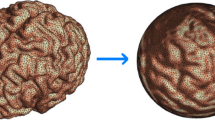Abstract
Sparsity of the signal has been shown to be very useful for blind source separation (BSS) problem which aims at recovering unknown sources from their mixtures. In this paper, we propose a novel algorithm based on the analysis sparse constraint of the source over an adaptive analysis dictionary to address BSS problem. This method has an alternating scheme by keeping all but one unknown fixed at a time so that the dictionary, the source, and the mixing matrix are estimated alternatively. In order to make better use of the sparsity constrain, \(l_{0}\)-norm is utilized directly for a more exact solution instead of its other relaxation, such as \(l_{\mathrm{p}}\)-norm (\(0<p\le 1\)). Numerical experiments show that the proposed method indeed improves the separation performance.







Similar content being viewed by others
Notes
Available at: http://md.cosmostat.org/Generalized_MCA.html.
Available at: http://md.cosmostat.org.
Available at: https://elad.cs.technion.ac.il/software/.
References
Hyvärinen A, Oja E (2000) Independent component analysis: algorithms and applications. Neural Netw 13(4):411–430
Bell A, Sejnowski T (1995) An information-maximization approach to blind separation and blind deconvolution. Neural Comput 7(6):1129–1159
Gaeta M, Lacoume JL (1990) Source separation without prior knowledge: the maximum likelihood solution. In: Proceeding EUSIPCO’90, pp 621–624
Belouchrani A, Cardoso JF (1994) Maximum likelihood source separation for discrete sources. In: Proceeding EUSIPCO’94, pp 768–771
Montoya-Martínez J, Cardoso JF, Gramfort A (2017) Caveats with stochastic gradient and maximum likelihood based ica for eeg. Lecture Note Computer Sci 10169:279–289
Tillet P, Kung HT, Cox D (2017) Infomax-ica using hessian-free optimization. Proceeding ICASSP’2017, pp 2537–2541
Zibulevsky M (2003) Sparse source separation with relative newton method. Proceeding ICA 2003:897–902
Choi H, Choi S (2007) A relative trust-region algorithm for independent component analysis. Neurocomputing 70(7):1502–1510
Byrd R, Lu P, Nocedal J, Zhu C (2003) A limited memory algorithm for bound constrained optimization. SIAM J Sci Comput 16(5):1190–1208
Ablin P, Cardoso J, Gramfort A (2018) Faster independent component analysis by preconditioning with hessian approximations. IEEE Trans Signal Process 66(15):4040–4049
Lee D, Seung H (1999) Learning the parts of objects by non-negative matrix factorization. Nature 401(6755):788–791
Boutsidis C, Gallopoulos E (2008) Svd based initialization: a head start for nonnegative matrix factorization. Pattern Recognit 41(4):1350–1362
Deng Z, Zhang S, Yang L, Zong M, Cheng D (2018) Sparse sample self-representation for subspace clustering. Neural Comput Appl 29:43–49
Zhu X, Suk HI, Huang H, Shen D (2017) Low-rank graph-regularized structured sparse regression for identifying genetic biomarkers. IEEE Trans Big Data 3(4):405–414
Zhang H, Wang S, Xu X, Chow TWS, Wu QMJ (2018) Tree2vector: learning a vectorial representation for tree-structured data. IEEE Trans Neural Netw Learn Syst 29(11):5304–5318
Alon U, Barkai N, Notterman D, Gish K, Ybarra S, Mack D, Levine A (1999) Broad patterns of gene expression revealed by clustering analysis of tumor and normal colon tissues probed by oligonucleotide arrays. Proc Natl Acad Sci United States of America 96(12):6745–6750
Shipp MA et al (2002) Diffuse large b-cell lymphoma outcome prediction by gene-expressionprofilingandsupervisedmachinelearning. NatureMed 8(1):68–74
Huang H, Zhao H, Li X, Ding S, Zhao L, Li Z (2018) An accurate and efficient device-free localization approach based on sparse coding in subspace. IEEE Access 6:61782–61799
Starck JL, Elad M, Donoho D (2004) Redundant multiscale transforms and their application for morphological component separation. Adv Imagin Electron Phys 132(4):287–348
Bobin J, Moudden Y, Starck JL, Elad M (2006) Morphological diversity and source separation. IEEE Signal Process Lett 13(7):409–412
Bobin J, Starck JL, Fadili J, Moudden Y (2007) Sparsity and morphological diversity in blind source separation. Image Process, IEEE Trans Image Process 16(11):2662–2674
Abolghasemi V, Ferdowsi S, Sanei S (2012) Blind separation of image sources via adaptive dictionary learning. IEEE Trans Image Process 21(6):2921–2930
Aharon M, Elad M, Bruckstein A (2006) K-svd: an algorithm for designing overcomplete dictionaries for sparse representation. IEEE Trans Signal Process 54(11):4311–4322
Zhao X, Zhou G, Dai W, Xu T, Wang W (2013) Joint image separation and dictionary learning. Proceedings DSP’2013, pp 1–6
Dai W, Xu T, Wang W (2011) Simultaneous codeword optimization (simco) for dictionary update and learning. IEEE Trans Signal Process 60(12):6340–6353
Nam S, Davies M, Elad M, Gribonval R (2011) The cosparse analysis model and algorithms. Appl Comput Harmonic Anal 34(1):30–56
Giryes R, Nam S, Elad M, Gribonval R, Davies M (2012) Greedylike algorithms for the cosparse analysis model. Linear Algebra Appl 441(1):22–60
Elad M, Milanfar P, Rubinstein R (2007) Analysis versus synthesis in signal priors. Inverse Probl 23(3):947
Fang W, Wang H, Xu B, Zhang Y (2016) Blind source separation using analysis sparse constraint. Electron Lett 52(13):1112–1114
Rubinstein R, Peleg T, Elad M (2013) Analysis k-svd: a dictionary-learning algorithm for the analysis sparse model. IEEE Trans Signal Process 61(3):661–677
Zhang Y, Wang H, Yu T, Wang W (2013) Subset pursuit for analysis dictionary learning. Proceeding EUSIPCO’2013, pp 1–5
Cai JF, Osher S, Shen Z (2009) Split bregman methods and frame based image restoration. Multiscale Model and Simul 8(2):337–369
Wu F, Jing X, Sun Y, Sun J, Huang L, Cui F, Sun Y (2018) Cross-project and within-project semisupervised software defect prediction: a unified approach. IEEE Trans Reliab 67(2):581–587
Wu F, Xi W, Han L, Jing X, Ji Y (2019) Multi-view synthesis and analysis dictionaries learning for classification. IEICE Trans Inf Syst E102 D(3):659–662
Acknowledgements
Thank all the referees and the editorial board members for their insightful comments and suggestions, which improved our paper significantly. This study was funded by the National Natural Science Foundation of China under Grant No. 11501351.
Author information
Authors and Affiliations
Corresponding author
Ethics declarations
Conflict of interest
The authors declare that they have no conflict of interest.
Additional information
Publisher's Note
Springer Nature remains neutral with regard to jurisdictional claims in published maps and institutional affiliations.
Rights and permissions
About this article
Cite this article
Ma, S., Zhang, H. & Miao, Z. Blind source separation for the analysis sparse model. Neural Comput & Applic 33, 8543–8553 (2021). https://doi.org/10.1007/s00521-020-05606-y
Received:
Accepted:
Published:
Issue Date:
DOI: https://doi.org/10.1007/s00521-020-05606-y




